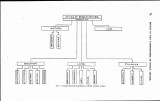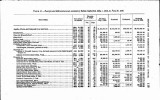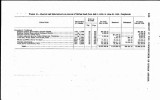| OCR Text |
Show REPOBT OF THE IYOMMISSIONEB OF INDIAIT APFAIJW. 15 SCHOOLS. Three hundred and -tbEge eovernment schools were conducted dur-ing the year, a net increase of 22. The number of mission schools' not under contract was 51, a decrease of 2. The mission schools under' contract numbered 8, as last year, making a total of 363 schools-an increase of 20 over 1908. Table 2 gives the details. The government schools fall into three classes: Nonreservation, reservation boarding, and day schools. Twenty-seven nonreservation boarding schools are in operation, an-increase of 1 over the number last year, the new school at Bismarck, N. Dak., having been opened on December 1, 1908. The enrollment' in these schools was 9,252, a decrease of 85, with an average attend-ance of 8,032, a decrease of 228. The details are shown in Table 3. A wise use of the facilities of these nonreservation schools naturally limits their enrollment to pupils who are old enough and strong enough to enter the industrial classes without danger to their health, and who will not need the constant, individual care of matrons. Accordingly circular instructions were issued as follows: Pupila under 14 who have been properly transferred to nonrese~ation schools either within a State or Territory, or in a distant State or Territory, will not be recalled, but may be continued inthenonresewationsehool or returned to it in the fallif home on a aummer visit; but no others &a11 he accepted; and no nonraervation superintendent may count in his average attendance pupils under 14 who are trs118ferred horn a reser-vation after the receipt of this circular, unless by special authority fmm the office; and . this authority will be given only when the school facilities on the reaervstion are ineu5cient or the reservation superintendent makkes the transfer, in which case the authority ahould be obtained from the office. Even in such contingency the law limits the choice to some echo01 within the State or Territory if transportation is to be paid by the Government. In the appropriation act for 1910, in approval of this economic pur-pose, Congress provided as follows: . P d e d , That no pupil under the ttge of 14 years shall be transported st government expense to an Indian school beyond the limit^ of the State m Territory in which the parents of auch children reside or of an adjoining State or Territory. The association of white and Indian children in school is a step of vital importance in working out the industrial and social salvation of Indians. In tlie act approved March 3, 1909, Congress said: Prouidedfurther, That hereafter white children may, under rules prescribed by the Commissioner of Indian Affaim, be admitted to Indian schools on the payment ot tuition few at a rate to be fixed in aaid rulee: Provided further, That all tuition few paid for whitechildren on enrollment ahall be deposited in the hands of the Treasurer to reimburse the funds out of which the school is supported. Five white pupils have been admitted to one of the boardingj I schools under this authority, and it is expected that the plan will also be put into operation, in an experimental way, this year on the Fort' |









































































































































































